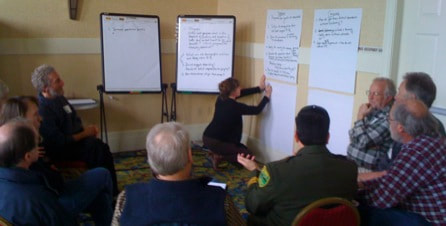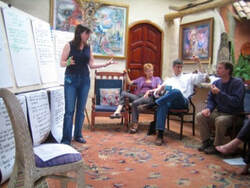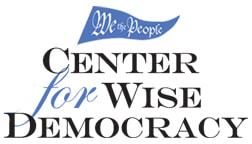
Dynamic Facilitation is a way of facilitating a small group of people to face and and solve difficult issues, even those that seem impossible to solve. The DF'er helps people face critical issues and then helps them to be creative in addressing them. Rather than asking participants to hold back their emotions, stay on the agenda, abide by guidelines, follow a step-by-step process and to generally be rational, the DF'er encourages people to just speak. At the same time he or she keeps everyone safe from judgment by reflecting what is said and holding a space where all comments can fit together. Four basic charts are used: Solutions, Concerns, Data, and Problem-statements. These charts help the DF'er frame the conversation as a creative quest to solve the issue. This allows people to trust their natural instincts more and appreciate what is emerging from self and others.
Using the charts the DF'er establishes a "zone of thinking and talking" that is "choice-creating," where shifts and breakthroughs are normal and where shared conclusions emerge. The process relies more on the skills and consciousness of the DF'er than on participant self-management. So ordinary, untrained people can be in the meetings and speak their minds and hearts, yet shifts and breakthroughs build exceptional group conclusions. And people come together as “We” with a shared story of progress.
Using the charts the DF'er establishes a "zone of thinking and talking" that is "choice-creating," where shifts and breakthroughs are normal and where shared conclusions emerge. The process relies more on the skills and consciousness of the DF'er than on participant self-management. So ordinary, untrained people can be in the meetings and speak their minds and hearts, yet shifts and breakthroughs build exceptional group conclusions. And people come together as “We” with a shared story of progress.

Sometimes the shifts and breakthroughs take the form of new ideas. Other times they bring a new sense of what the "real problem" is, or a change of heart. At the end of a dynamically facilitated meeting, a fifth chart is used to capture group conclusions, what we call "Of Courses", the basic choices for going forward.
Dynamic Facilitation opens the door to a thinking process, which sometimes emerges naturally in a crisis, where people drop their roles and positions, open up and share what they really think, work together in surprising ways, and make progress that would normally be impossible. ... Dynamic Facilitation is especially valuable in such difficult settings ... yet it should be used on a regular basis rather than only when facing an impossible-seeming issue.
Dynamic Facilitation opens the door to a thinking process, which sometimes emerges naturally in a crisis, where people drop their roles and positions, open up and share what they really think, work together in surprising ways, and make progress that would normally be impossible. ... Dynamic Facilitation is especially valuable in such difficult settings ... yet it should be used on a regular basis rather than only when facing an impossible-seeming issue.
Andrea Gewessler describes Dynamic Facilitation (DF)
In a DF session, we get everyone to speak on the question which occupies the thinking of a group or team. The facilitator who takes down everything that’s being said on one of the four flipcharts entitled problem statement, solutions, concerns and data, facilitates the normalising and acceptance of whatever comes up, pays attention to the stories and the feelings behind it. The stories often go on the information chart, the feelings on the concerns. In the initial hour, it is rarely creativity that rules. Participants are eager to get off their chests what they have wanted to say, what they have wanted to be witnessed to say, they are keen to be heard out and to be acknowledged. It is quite common for one participant to have a real go at explaining what’s wrong and what needs to change. DFers call it the purge. The word purge stems from the Latin purgare "cleanse, make clean; purify," especially in reference to the body, "free from what is superfluous; remove, clear away," (https://www.etymonline.com/word/purge) It is through that process of shared collective awareness raising of what’s really going on in the room for all those participating in this conversation, as well as through some subtle but important ways of facilitating and being present as a facilitator, that mutual trust increased and at least some if not all of the participants can move into a ‘by me’ state, where the locus of control shifts from being outside, i.e. someone else needs to change or fix things to the inside, where we can take radical responsibility for what’s going on. Participants connect to what they can control and what can be changed; they connect to their passion and so create new choices. Jim Rough says that dynamic facilitation is a way of reliably enabling choice-creating. He clearly distinguishes between choice creating and decision making. The origin of the word decision comes from cutting away. In our fast-paced world we can be eager to come up with solutions quickly. We can feel compelled to be decisive, to take decisions swiftly, to quickly decide what’s right or wrong or what’s the best way. And, while that can be a really good way for technical, complicated issues, the increasing complexity of our world and the issues we experience at work and in our lives, call for a different way. Enter choice-creating. For choice-creating to occur, we need to engage in a different way of listening, of being, of allowing feelings, thoughts and intuition to merge. It’s to show up authentically and as fully embodied as we can manage.
